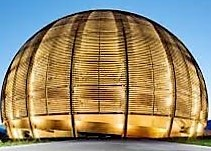Speaker
Description
Understanding the production and survival of $\mathrm{^{205}{Pb}}$ in stars is pivotal as $\mathrm{^{205}{Pb}}$ is the only short-lived radionuclide that is produced exclusively by the slow neutron capture process (s-process). The ratio of radioactive $\mathrm{^{205}{Pb}}$ to stable $\mathrm{^{204}{Pb}}$, when compared to the expected value from the continuous galactic nucleosynthesis, helps to constrain nucleosynthesis activity just prior to the Sun’s birth. Concerns were raised on the validity of $\mathrm{^{205}{Pb}}$ as a cosmochronometer [1] as the $\mathrm{^{205}{Pb}}$/$\mathrm{^{204}{Pb}}$ ratio is strongly affected due to the existence of the 2.3 keV excited state in $\mathrm{^{205}{Pb}}$, from which the electron capture decay to $\mathrm{^{205}{Tl}}$ is expected to be significantly faster than from the ground state ($t_{1/2}$ = 17.3(7) Myr). However, it was pointed out [2] that the bound-state beta decay [3], an exotic decay mode in which an electron is directly created in one of the empty atomic orbitals instead of being emitted into the continuum, of $\mathrm{^{205}{Tl}}$ could counter-balance the reduction of $\mathrm{^{205}{Pb}}$. $\newline$
In this talk, the authors report on the first direct measurement of the half-life of the bound-state beta decay of fully-stripped $\mathrm{^{205}{Tl}^{81+}}$ ions to the 2.3 keV excited state of $\mathrm{^{205}{Pb}^{81+}}$ ions [4], which was realized in the spring beamtime at the heavy-ion storage ring ESR at GSI, Darmstadt in 2020, wherein the entire accelerator chain was employed. $\mathrm{^{205}{Tl}^{81+}}$ ions (with no electron) were produced with the projectile fragmentation of $\mathrm{^{206}{Pb}}$ primary beam on $\mathrm{^{9}{Be}}$ target, separated in the fragment separator (FRS), accumulated, cooled, and stored for different storage times (up to 10 hours) in the experimental storage ring (ESR). The consequences of the measurement on the source of the live $\mathrm{^{205}{Pb}}$ in the early solar system will be stressed in the talk. $\newline$
This research has been conducted in the framework of the SPARC, ILIMA, LOREX, NucAR collaborations, experiment E121 of FAIR Phase-0 supported by GSI. The authors received support from the European Research Council (ERC) under the European Union's Horizon 2020 research and innovation program (Grant Agreement No. 682841 "ASTRUm"). $\newline$
References:
[1] J. B. Blake et al., Nature 242, 98, (1973).
[2] K. Yokoi et al., Astron. and Astrophys. 145, 339, (1985).
[3] R. Daudel et al., J. Phys. Radium 8, 238, (1947).
[4] Ragandeep Singh Sidhu, Ph.D. Thesis, Ruprecht-Karls-Universität, (2021).




